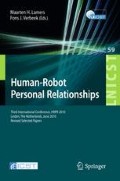Abstract
As the development of autonomous robots has moved towards creating social robots, children’s interactions with robots will soon need to be investigated. This paper examines how children think about and attribute features of friendship to a robot. A total of 184 children between ages 5 to 16 years visiting a science centre were randomly selected to participate in an experiment with an approximate even number of boys and girls. Children were interviewed after observing a traditional small 5 degree of freedom robot arm, perform a block stacking task. A set of experiments was conducted to measure children’s perceptions of affiliation with the robot. Content analysis revealed that a large majority would consider a relationship with the robot, and participate in friendship-type behaviors with it. Significant sex differences in how children ascribe characteristics of friendship to a robot were also found.
Access this chapter
Tax calculation will be finalised at checkout
Purchases are for personal use only
Preview
Unable to display preview. Download preview PDF.
References
Heerink, M., Kröse, B., Evers, V., Wielinga, B.: The influence of social presence on acceptance of a companion robot by older people. Journal of Physical Agents 2(2), 33–40 (2008)
Kerepesi, A., Kubinyi, E., Jonsson, G.K., Magnusson, M.S., Miklósi, Á.: Behavioural comparison of human-animal (dog) and human-robot (AIBO) interactions. Behavioural Processes 73, 92–99 (2006)
Turkle, S.: Life on the screen: Identity in the age of the internet. Simon & Schuster, NY (1995)
Melson, G.F., Kahn Jr., P.H., Beck, A., Friedman, B., Roberts, T., Garrett, E., Gill, B.T.: Children’s behaviour toward and understanding of robotic and living dogs. Journal of Applied Developmental Psychology 30, 92–102 (2009)
Rubin, K.H., Bukowski, W.M., Parker, J.G.: Peer interactions, relationships, groups. In: Damon, W., Lerner, R.M., Eisenberg, N. (eds.) Social, emotional, and personality development, 6th edn. Handbook of child psychology, vol. 3, pp. 571–645. Wiley, New York (2006)
Author information
Authors and Affiliations
Editor information
Editors and Affiliations
Rights and permissions
Copyright information
© 2011 ICST Institute for Computer Science, Social Informatics and Telecommunications Engineering
About this paper
Cite this paper
Beran, T.N., Ramirez-Serrano, A. (2011). Can Children Have a Relationship with a Robot?. In: Lamers, M.H., Verbeek, F.J. (eds) Human-Robot Personal Relationships. HRPR 2010. Lecture Notes of the Institute for Computer Sciences, Social Informatics and Telecommunications Engineering, vol 59. Springer, Berlin, Heidelberg. https://doi.org/10.1007/978-3-642-19385-9_7
Download citation
DOI: https://doi.org/10.1007/978-3-642-19385-9_7
Publisher Name: Springer, Berlin, Heidelberg
Print ISBN: 978-3-642-19384-2
Online ISBN: 978-3-642-19385-9
eBook Packages: Computer ScienceComputer Science (R0)

